
Many of these items are highly regulated, with stiff penalties for failure to comply with national and local laws. This adds to the “mystique” of many ordnance items, notably machine guns, artillery pieces and tanks. Compliance with some of these laws is costly, and this further drives up pricing.

The pricing found in the firearms portion of this book is different than that found in the remainder of the book. For the most part, collectors shun reproductions or fakes; however, an exception seems to exist in this regard when it comes to weapons. A firearm is a key part of many Vietnam displays, exhibits and mannequin dressing.
In many areas, regulation has made this difficult, particularly if items are displayed publicly, especially at schools. Hence, a legitimate market has developed for demilitarized or dummy weapons, as well as automatic weapon replicas capable of firing as semi-automatics. Hence, pricing is given for live, fully automatic, legally transferable weapons, semi-automatic variants, and demilitarized or dummy weapons.
Similarly, grenades and rockets listed in the Warman’s Vietnam Collectibles book are either demilitarized or expended. This is NOT the same thing as an inert or dummy grenade—the latter being much more common and much less valuable or desirable.
Armored fighting vehicles and self-propelled weapons are also listed. Collecting this equipment is a hobby unto itself; however, many vehicle collectors completely outfit their vehicles with period gear and wear authentic clothing while operating them. Private ownership of these vehicles is legal in the United States, although some localities have imposed restrictions.

Many of the armored vehicles used in the Vietnam War are still being used by U.S. soldiers today, and hence are not readily available on the market. Also, the Department of Defense has severely curtailed the sales of such vehicles domestically, while the State Department is not currently allowing any such vehicles to be repatriated. Cannon ownership, whether mounted on a vehicle or towed, is also legal.
However, if the cannon is capable of firing, its breech must be registered with the Bureau of Alcohol, Tobacco and Firearms (BATF) as a destructive device. The values indicated for these items assume a non-firing gun.
Be aware that the army considers most tanks, armored vehicles and cannons on display at VFW’s, American Legions and city parks to still be federal property. Do not consider buying or trading for such an item without an irrefutable chain of title, including a release from the federal government. This article is an excerpt from Warman's Vietnam War Collectibles by David Doyle.

Next Step: Get your FREE Printable Target Pack
Enhance your shooting precision with our 62 MOA Targets, perfect for rifles and handguns. Crafted in collaboration with Storm Tactical for accuracy and versatility.
Subscribe to the Gun Digest email newsletter and get your downloadable target pack sent straight to your inbox. Stay updated with the latest firearms info in the industry.

![Best Concealed Carry Guns In 2025 [Field Tested] Wilson Combat EDC X9S 1](https://gundigest.com/wp-content/uploads/Wilson-Combat-EDC-X9S-1-324x160.jpg)


![Best 9mm Carbine: Affordable PCCs [Tested] Ruger Carbine Shooting](https://gundigest.com/wp-content/uploads/Ruger-Carbine-Shooting-100x70.jpg)
![Best AR-15: Top Options Available Today [Field Tested] Harrington and Richardson PSA XM177E2 feature](https://gundigest.com/wp-content/uploads/Harrington-and-Richardson-PSA-XM177E2-feature-100x70.jpg)
